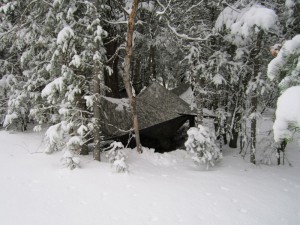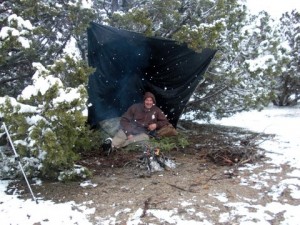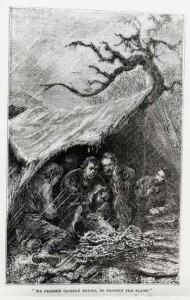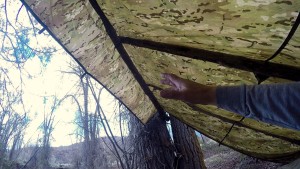Tarp Shelter Tips – Making a Tarp Shelter More Secure
There are few things that are common mistakes in setting up tarp shelters.
- Roof set up
- Reinforcing the tarp fabric
- Making a livable Space
I love tarps because I can make so many different styles of shelters out of them. A tent is already pre-designed, its shape is predetermined, the advantage to that is a person does not have to think about how to set it up. I like to be able to look around at my surroundings which is one of the pluses with tarp shelters. One of the other great things about tarp shelters is they can be set up so many different ways, whatever the need it can be configured to match. The disadvantage with tarps is that a person has to be creative to use them properly. At each campsite you evaluate the layout, the surroundings, you think about how best to set up. It’s possible with our PSTL tarp to do more than 50 kinds of set ups, with this in mind it may be helpful to learn the style groups for square tarps, then you can easily choose the style first, then dial in the best set up.
The listing below is to give an idea of how the styles are broken down. A subsequent blog article will cover these in greater detail. The brief definition of each style should serve to form a mental picture for this article.
- Canopy – is defined as a tarp set up where no part of the tarp touches the ground
- Lean To – this style is characterized by having only one edge touch the ground
- Diagonal or Diamond – these are set ups in which two adjacent edges touch the ground, these edges are on each side of an anchored corner
- “A” Frame – this variety of shelter is set up with two opposing edges touching the ground and includes not just the “A” shaped tarps, but also those with rounded tops or divided angle tops
- Ground Cloth – there are many varieties of ground cloth set ups which may be included, at least 1/3rd of the tarp must rest on the ground
- Hybrid – primarily this style is for use when combining more than one tarp to form a larger shelter. It may also include anything that does not fall into one of the five styles listed above

There are some basic ground rules or tips that should be observed to maximize the value of tarp shelter. In easy weather almost anything will work, it’s when things turn sour that a proper set up pays huge dividends. As mentioned at the beginning, three areas of concern, any of which can make or break any set up. Next I’ll examine each of these, for purpose of this article, let’s use a Lean To.
In most cases the roof is the primary reason for constructing the shelter in the first place, the only other reasons really would be ground cloth or a wall. For this article we are going to assume correct location of the shelter, suitable ground for it and safety.
Some Factors for a Proper Roof
- Slope
- Anchoring and support
- Orientation
Slope
I have seen quite a lot of Lean To shelters where the roof has so little slope that it is nearly horizontal. A flat roof is fine for shade purposes, but if there is any rain or snow it had better have a decent pitch to it. With a good tarp it is advised to have at least a 45 degree angle. For reference, do a salute, this is about right. For heavier rain or snow, it would be best to have a 60 – 70 degree slope. Water should run off as quickly as possible, no pooling, any tarp can develop a leaky spot either from tiny holes or wear in the sealing coating, a steeper pitch helps to offset these possible conditions. Generally a flatter roof is often chosen to accommodate more people since the steeper the pitch the smaller the footprint of the shelter.
TIP – Another option in set up, is allowing for an awning. Anytime there is rainy weather an awning should be used. On a Lean To an awning is simply made by putting the ridge pole or ridge line a foot or more back from the top edge of the shelter, then tying it off so it slopes at about 45 degrees.
Many times this step is neglected by not giving it the consideration it deserves. Shortchanging this step results frequently in the need to get up in the night, in the rain to try and secure the shelter. Unfortunately it often leads to torn or damaged tarps as winds whip loose sections around.
In a Lean To a stout ridge pole or taut ridge line are essential, this one edge has to bear considerable force in a wind against the shelter. A ridge pole needs to be plenty secure. Often it is assumed that all is well, but when the storm hits, things move far more than one might expect. Securely tying off pays big rewards when a storm blows in at 2 am.
When staking the edge on the ground try to pull it taut, loose fabric has more friction in the wind, and excess flapping will keep you from sleeping. When staking, I like to do the corners first, then pull out the middle. One more thing to consider while getting the tarp adjusted is to make sure there is nothing to impede the flow of water. Sometimes supports or cord that runs laterally across the tarp can cause a high point that will collect water, even a small puddle can grow as the weight of it causes the fabric to sink, making a larger collection basin. Areas like this can lead to leaks or even pull at the shelter perhaps causing it to fail.
Orientation
When building an outdoor camp shelter, it is important to think about how it is oriented to get to most good out of it. If a storm is eminent make sure it can’t blow into the shelter inasmuch as possible. In cold weather it can be helpful to face the shelter to take advantage of the sun for heating. Many times capturing the morning sun can get the day started right. Also make sure entry and exit are clear, nothing is more aggravating than having to make a fuss every time a person gets into or out of a shelter.
When able to, make sure to set the shelter up to allow comfort, make it livable. Many people just make shelter with little thought other than a roof over their head, others try to be primitive and austere, actually the goal should be to make oneself comfortable. To me the beauty of using a tarp shelter is being able to see nature, to see the forest from the comfort of my Lean To. There is nothing quite like laying on my bough bed with my Survival Blanket hearing the rain pounding on the tarp fabric and seeing the mist in the trees, feeling the breeze and smelling the fresh ions released by the rain. A well thought out tarp shelter can be the key to enjoying the outdoors.
Be sure to watch our YouTube playlist, Tarp Setups, to see how to set up our tarps and for ideas on types of set ups. Check out our website to look at the tarp options available. Our tarps are sold ready to use, and include cordage, stakes, and shock cord.
Until next time, this is Perry Peacock, for Simplifying Survival





